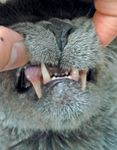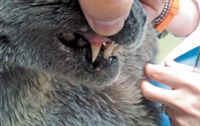Feline acromegaly: The keys to diagnosis
Drs. Wakayama and Bruyette offer a look at which diagnostic tests are most beneficial in detecting this often underdiagnosed condition.
Feline acromegaly is a disease characterized by excessive growth hormone secretion, leading to a wide array of clinical signs caused by the hormone's effects on multiple organ systems. These effects can be divided into two major classes: catabolic and anabolic. The catabolic actions of growth hormone include insulin antagonism and lipolysis, with the net effect of promoting hyperglycemia. The slow anabolic (or hypertrophic) effects of growth hormone are mediated by insulin-like growth factors.

Growth hormone stimulates the production of insulin-like growth factors in several tissues throughout the body. Insulin-like growth factor-1 (IGF-1), which is produced in the liver, is thought to be the key factor that facilitates the anabolic effects of growth hormone that are responsible for the characteristic appearance of people, dogs, and cats with acromegaly.
Similar to its etiology in people, acromegaly in cats is the result of a functional adenoma of the pituitary gland that releases excessive growth hormone despite negative feedback.1
ANATOMY AND PHYSIOLOGY
Growth hormone is produced in an anterior lobe of the pituitary gland, specifically by cells called somatotrophs. The regulation of growth hormone is complex, and many factors—both environmental and endogenous—are responsible for its control. The two most important regulators of growth hormone production and release are growth hormone-releasing hormone (GHRH) and somatostatin, which are produced in the hypothalamus. While growth hormone release is stimulated by GHRH, it is inhibited by somatostatin as well as by negative feedback from itself and IGF-1.1
SIGNALMENT
Feline acromegaly is an uncommon disease, although it is thought to be underdiagnosed. It most commonly affects middle-aged and older, male castrated cats. In one study, 13 of 14 cats with acromegaly were males, with an average age of 10.2 years.2 This association may be biased, however, as most cats in which acromegaly is diagnosed are presented for complications associated with diabetes mellitus, which is also common in older, male castrated cats. Based on available data, no known breed association for feline acromegaly exists.
CLINICAL SIGNS
Cats with acromegaly are commonly presented for insulin-resistant diabetes mellitus (insulin doses dependent on insulin type) with concurrent weight gain rather than weight loss.2 Other clinical signs vary because of the wide range of effects the disease has on the body.

1. This domestic shorthaired cat with presumptive acromegaly is exhibiting a broadened face, a physical change commonly associated with feline acromegaly. The cat was presented for unregulated diabetes.
Physical changes associated with feline acromegaly include increased body weight, a broadened face, enlarged feet, protrusion of the mandible (prognathia inferior), increased interdental spacing, organomegaly, and a poor coat (Figures 1-3).
Respiratory disease may result from excessive growth of the soft palate and laryngeal tissues, leading to stertorous breathing and even upper airway obstruction. Cardiovascular signs include the presence of a heart murmur, hypertension, arrhythmia, and congestive heart failure associated with hypertrophic cardiomyopathy.3

2. The same cat as in Figure 1 exhibiting another physical change associated with feline acromegaly-protrusion of the mandible.
Neurologic disease associated with feline acromegaly is uncommon but can occur with large pituitary adenomas. Neurologic signs that have been observed with acromegaly include dullness, lethargy, abnormal behavior, circling, and blindness.
Glomerulopathy and secondary renal failure have also been associated with feline acromegaly. Histologic evaluation of the kidneys of cats with acromegaly has revealed thickening of the glomerular basement membrane and Bowman's capsule, periglomerular fibrosis, and degeneration of the renal tubules.2

3. This close-up of the cat's teeth (the same cat as in Figures 1 & 2) highlights increased interdental spacing, another physical change associated with feline acromegaly.
Because of an associated degenerative arthropathy and peripheral (diabetic) neuropathy, lameness has also been noted in cats with acromegaly.
DIAGNOSIS
No single test for the diagnosis of feline acromegaly exists. Diagnosing feline acromegaly starts with a clinical suspicion based on a thorough history, signalment, and clinical signs. Many of the abnormalities noted in the complete blood counts, serum chemistry profiles, and urinalyses of affected cats reflect concurrent diabetes mellitus, which stresses the need to carefully evaluate a patient's clinical history.
Common laboratory abnormalities associated with diabetes mellitus include hyperglycemia, increased liver enzyme activities (alanine transaminase, alkaline phosphatase), hypercholesterolemia, glucosuria, and isosthenuria. Also, since many cats with acromegaly are presented for evaluation of uncontrolled diabetes mellitus, azotemia and ketonuria are common.
Other common findings include erythrocytosis due to anabolic effects of growth hormone and IGF-1 and proteinuria secondary to glomerulonephropathy. Unexplained hyperphosphatemia and hyperglobulinemia have also been noted.1,2,4
Growth hormone assay
Serum growth hormone is often measured to help diagnose acromegaly in people; however, assays specific for feline growth hormone are not widely available. An assay using ovine growth hormone as the antigen has been validated for use in cats, but it is only available in Europe.5
Even if an assay were available, growth hormone concentrations alone may not be a reliable diagnostic test for acromegaly since growth hormone production is cyclic and concentrations may vary throughout the day.1 Relying on a single growth hormone measurement can be misleading.
Additionally, it has been shown that growth hormone concentrations may be elevated in diabetic cats that do not have acromegaly.6,7 This elevation may be due to the fact that the liver requires high levels of portal insulin to produce IGF-1, and in uncontrolled diabetics portal insulin concentrations may remain low, resulting in decreased IGF-1 production and, theoretically, decreased inhibition of growth hormone release.5,7
Finally, growth hormone concentrations may not be elevated early in the course of the disease but may increase significantly later.1
Serum IGF-1
Serum IGF-1 measurement is the most commonly used diagnostic test for feline acromegaly and is readily available in the United States. Unlike growth hormone, IGF-1 concentrations are less likely to fluctuate over the course of the day since most IGF-1 is protein-bound, giving it a longer half-life in the body. In addition, IGF-1 concentrations increase in response to chronically elevated growth hormone concentrations and are thought to be a reflection of growth hormone concentrations over the last 24 hours.1,8
A recent study evaluating IGF-1 concentrations in confirmed acromegalic diabetic cats, diabetic cats, and healthy cats found that acromegalic diabetic cats had significantly higher IGF-1 concentrations than diabetic and nondiabetic cats.9 This study concluded that serum IGF-1 concentration measurement is 84% sensitive and 92% specific for diagnosing feline acromegaly.
Just as with growth hormone, elevations in IGF-1 concentration alone may not definitively diagnose acromegaly in a cat. One study found that IGF-1 concentrations in nonacromegalic diabetic cats receiving long-term insulin treatment (> 14 months) had higher concentrations of IGF-1 than nondiabetic cats.8 It was proposed that insulin treatment allowed for beta cell regeneration and increased portal insulin, leading to elevations in IGF-1 concentrations.
In addition, another study revealed that untreated diabetic cats with acromegaly can have low to normal IGF-1 concentrations that increase after starting insulin therapy.7 The results of this study indicate that retesting IGF-1 concentrations a few weeks after starting insulin therapy or even after increasing insulin dosages in patients with suspected acromegaly that had low or normal IGF-1 concentrations may be warranted.
Diagnostic imaging
Radiographic findings associated with feline acromegaly are related to the hypertrophic or anabolic effects of excessive growth hormone. Hyperostosis of the calvarium, spondylosis of the spine, and protrusion of the mandible are common findings. Periosteal reaction, osteophyte production, soft tissue swelling, and collapse of joint spaces are signs associated with the degenerative arthropathy linked to feline acromegaly. Thoracic radiography may reveal cardiomegaly and congestive heart failure. Nonspecific signs such as abdominal organomegaly (hepatic, renal, adrenal) may be revealed by abdominal radiography and ultrasonography.
Advanced imaging is needed to document the presence of a pituitary adenoma. Computed tomography and magnetic resonance imaging (MRI) are both useful for identifying pituitary masses.10,11 However, MRI is thought to be the more sensitive imaging modality.
The presence of a pituitary tumor alone is not diagnostic for feline acromegaly since other functional tumors of the pituitary gland, such as ACTH-producing tumors in patients with Cushing's disease, may also result in insulin-resistant diabetes. Conversely, the absence of a pituitary mass does not rule out acromegaly since a case has been reported in which a patient had negative MRI results but a pituitary mass was identified at necropsy and histopathology results confirmed feline acromegaly.6
Histologic examination
Histologic examination of the pituitary tumor is necessary for a definitive diagnosis, which makes antemortem diagnosis challenging. However, with advances in surgical procedures, such as transsphenoidal hypophysectomy, surgical excisional biopsy is possible. The main histologic change associated with acromegaly is proliferation of somatotrophs.1
Adrenocortical testing
As stated earlier, a common presenting complaint for patients with acromegaly is insulin resistance with weight gain. Although rare, hyperadrenocorticism can be mistaken for feline acromegaly since both of these diseases can be associated with insulin-resistant diabetes mellitus (and associated clinical signs), a pituitary mass, and bilateral adrenomegaly. As such, hyperadrenocorticism is an important differential diagnosis to keep in mind should diagnostic testing for feline acromegaly produce vague or unequivocal results.
CONCLUSION
Feline acromegaly is likely an underdiagnosed disease in older male cats, especially in ones with insulin-resistant diabetes. A recent study in the United Kingdom measured IGF-1 concentrations in variably controlled diabetic cats. Of the 184 cases, 59 (32%) had markedly increased IGF-1 concentrations. Eighteen of these 59 cats underwent pituitary imaging, confirming a diagnosis of acromegaly in 17/18 (94%).6 This study illustrates the importance of ensuring that we remain aware of feline acromegaly so that we may more consistently diagnose and treat these patients.
For information regarding treatment options in cats with acromegaly, see the article "Feline acromegaly: Treatment options".
Justin Wakayama, DVM Department of Veterinary Clinical Sciences College of Veterinary Medicine University of Minnesota St. Paul, MN 55108
David S. Bruyette, DVM, DACVIM VCA West Los Angeles Animal Hospital 1900 S. Sepulveda Blvd. West Los Angeles, CA 90025
Veterinary Diagnostic Investigation and Consultation 26205 Fairside Road Malibu, CA 90256